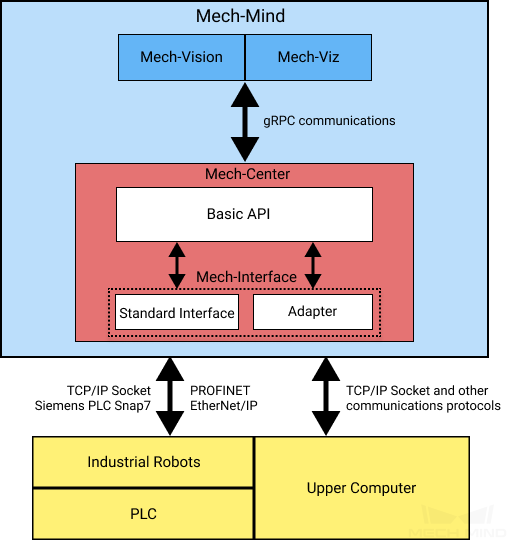Mech-Interface
Mech-Interface provides communication service with external devices for the Mech-Mind Software Suite. It receives data from external devices and sends out data from the system. It consists of two parts: Standard Interface and Adapter. This section covers the mechanism, differences between the two types of communication (Standard Interface and Adapter) of Mech-Interface, and their application scenarios.
Communication Mechanism
The two types of communication mechanism are as shown in the figure below:

-
Adapter is a Python program that is used to establish communication between external communication devices (e.g., industrial robots, upper computers, PLC) and Mech-Vision and Mech-Viz . It can not only communicate with Mech-Vision and Mech-Viz, but also communicate with external devices over any communication protocol supported by Python.
-
Standard Interface can be viewed as a complete set of Adapter programs provided by Mech-Mind. It supports a number of communication protocols and provides a powerful control command set and an error monitoring system. With these powerful functions, it can meet the requirements of most users.
Differences between Standard Interface and Adapter
Adapter and Standard Interface are both used to establish communication between external devices and Mech-Vision and Mech-Viz. Standard interface is a set of standardized Adapter programs, which does not support customized development.
For internal communication with Mech-Vision and Mech-Viz, both types of communication utilize Basic API, while specific communication protocols are used to communicate with external devices.
The differences between Standard Interface and Adapter are as shown in the table below.
| Differences or Similarity | Standard Interface | Adapter |
|---|---|---|
Internal Communication |
Utilize Basic API to communicate with Mech-Vision and Mech-Viz |
|
External Communication |
Support the following communication protocols only:
|
Support any type of communication protocol supported by Python |
Function |
Provide vision results only |
Adapter not only provides visual-related functions but also offers Python-supported functions like interface, database, and order system. |
Deployment Difficulty |
Easy to use, and can be deployed rapidly |
Require programming with high time and labor costs |
Extensibility |
Do not support extension |
Can be extended to support more communication protocols and functions |
Application Scenarios
In real application scenarios, the selection of a specific type of Mech-Interface is based on external communication devices, the communication protocol in use, the required communication functions, etc.
The common communication devices and protocols supported by Standard Interface and Adapter are as shown in the table below.
| Communication Object | Communication Protocol | Mech-Interface Type | Description |
|---|---|---|---|
Robot |
TCP/IP Socket |
Standard Interface |
Mech-Interface acts as the server |
UDP |
Mech-Interface acts as the server |
||
PROFINET |
Mech-Interface acts as the slave device |
||
EtherNet/IP |
Mech-Interface acts as the slave device |
||
Modbus TCP |
Mech-Interface acts as the slave device |
||
Upper Computer |
HTTP |
Adapter |
Applicable to integrated project where the robots are master-controlled |
WebSocket |
|||
TCP/IP Socket |
Standard Interface |
Mech-Interface acts as the server |
|
PLC |
TCP/IP Socket |
Standard Interface |
Mech-Interface acts as the server |
Siemens PLC Snap7 |
Mech-Interface acts as the client |
||
PROFINET |
Mech-Interface acts as the slave device |
||
EtherNet/IP |
Mech-Interface acts as the slave device |
||
Modbus TCP |
Mech-Interface acts as the slave device |
||
Mitsubishi MC |
Mech-Interface acts as the client |
|
Please refer to the following sections for more detailed information about Standard Interface and Adapter: